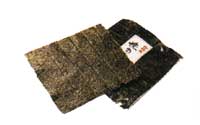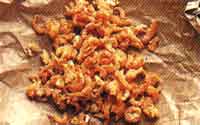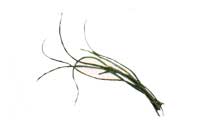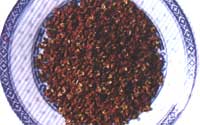
Asian Online Recipes (Food Glossary)

|
|
|
|
|
|
A B C D E F G H I J K L M N O P Q R S T U V W X Y Z
| Saffron Powder and threads | Made from the dried thread-like stigmas of the saffron crocus, this costly spice adds a vivid yellow color and subtle flavor to food. It is available as bright orange threads or ground into powder. Saffron threads are usually soaked in a little warm water before use, then squeezed out to release the color into the water. The threads and liquid are then both added to dish to give the characteristic saffron coloring. |
 |
| Sage | Sage is an herb from an evergreen shrub, Salvia officinalis, in the mint family. Its long, grayishgreen leaves take on a velvety, cottonlike texture when rubbed (meaning ground lightly and passed through a coarse sieve). | |
| Sake | A clear-colored Japanese liquor made from fermented rice. It should be used within a year of manufacture and once a bottle is opened, it should be used as soon as possible or it will begin to lose its flavor. | |
| Sambal Oelek | This is a hot paste made from fresh red chilies, mashed and mixed with salt. it is used as a relish in Indonesian and Malaysian cooking and can be used as a substitute for fresh chilies in most recipes. Covered, it will keep for months in the refrigerator. |
 |
| Sausage, Chinese (lap cheong) | Cured pork sausages about 15 cm (6 in) in length with a sweet flavor. Refrigerate up to one month or freeze up to several months. | |
| Scallions | See Spring onions | |
| Seaweed, dried | Dried seaweed is usually available in sheets. Keeps indefinitely on the shelf. Some seaweed sheets are more expensive because they are roasted and seasoned. These are used in Japanese cooking. |
 |
| Sesame seed oil | Golden brown oil of sesame seeds and very aromatic. Has a rich and nutty flavor and is used as a flavoring in Chinese, Korean and Japanese dishes and is not used for frying Buy in small quantities and store in a cool dark place. Do not refrigerate as it will turn cloudy. Add to dishes just before serving. | |
| Sesame seed (white) | The tiny, oval, oil-rich seeds of an annual herb, sesame seeds are used throughout Asia for their flavor and their high protein content. The white sesame seeds are the most commonly used. They are toasted and crushed and are an essential ingredient in Japanese and Korean dressings, dipping sauces and marinades. Whole seeds are used as a garnish for both savory and sweet dishes and breads. Pressed seeds are made into a variety of pastes. Japanese sesame seeds are plumper and have a nuttier flavor than other sesame seeds. |
 |
| Sesame seed (black) | Black sesame seeds have a more earthy taste. They are used in sesame and seaweed sprinkle, a Japanese condiment and in some Chinese desserts. |
 |
| Shallots, red Asian | Small reddish-purple onions, these grow in bulbs, like garlic and are sold in segments that look like large cloves of garlic. They have a concentrated flavor and are easy to slice and grind. If unavailable. substitute French shallots or brown or red onions. |
 |
| Shaosing | See Rice Wine, Chinese | |
| Shoshoyu | See Soy Sauce, Japanese |
 |
| Shrimp, dried | Dried tiny shrimp. Soak in warm water for about 1/2 hour to soften before use. Keeps on shelf indefinitely in covered jars. |
 |
| Shrimp sauce | See Bagoong |
 |
| Singapore noodles | See Noodles Hokkien |
 |
| Snake beans | Also called long beans and yard-long beans. This bean grows wild in tropical Africa, where it probably originated. Growing to 38 cm (15 inches) and more long, with a crunchy texture and similar taste to green beans, they are available in two varieties : pale green with slightly fibrous flesh, and darker green with firmer flesh. Use when as fresh as possible. Just snip off the ends and cut into bite-sized pieces. String-less green beans can be used instead. |
 |
| Snow peas (Chinese pea pods) | Flat edible pea pod. Has a delicate taste and comes fresh or frozen. Must string as in green beans before cooking. | |
| Soy sauce | The extract of fermented soybeans combined with salt. Soy sauce range from light to dark. Light soy sauce is the most delicate, and is used as a dip or in cooking; gives little color. Some dark soy sauce has caramel added for color and is slightly sweet. Japanese soy sauce is in the middle and serves most purposes very well. | |
| Soy sauce, Japanese | Japanese soy sauce is also known as shoshoyu and is less salty, much lighter and sweeter than standard soy sauce and because it is naturally brewed, it must be refrigerated after opening. |
 |
| Spring onions | Also called green onions and scallions, these are immature onions which are pulled before the bulb has started to form and sold in bunches with the roots intact. Discard the roots and base of the stem, and wash the stem leaves well before use. Spring onions add color and a mild onion flavor and they need little cooking. |
 |
| Star anise | The dried star-shaped seed pod of a tree native to China, star anise adds a distinctive aniseed taste to long-simmered meat and poultry dishes and is one of the components of five spice powder. Available whole or ground. |
 |
| Star Fruit | See Carambola |
 |
| Stir fry | To toss, cook or saute in English, Chow in Chinese. Slices of vegetables, meats, or a combination are cooked quickly in the wok with a small amount of oil. Liquid may be added to make a sauce and cornstarch is used for thickening. Foods retain more food value, color and texture. | |
| Summer Savory | Summer Savory is an annual herb, Satureja hotenis, belonging to the mint family. Its dark-green, narrow leaves are dried and crushed. | |
| Sweet soy sauce | See Kecap Manis |
 |
| Szechwan peppercorns | Reddish-brown peppercorns, much stronger than either black or white peppercorns of the West. Usually sold in plastic bags. Will keep indefinitely in a tightly sealed container. |
 |
| Szechwan vegetable | The knobby bulb of a radish preserved in chili pepper and salt. Rinse before using. Store airtight in jar. Refrigerate indefinitely. No substitutes. |
|